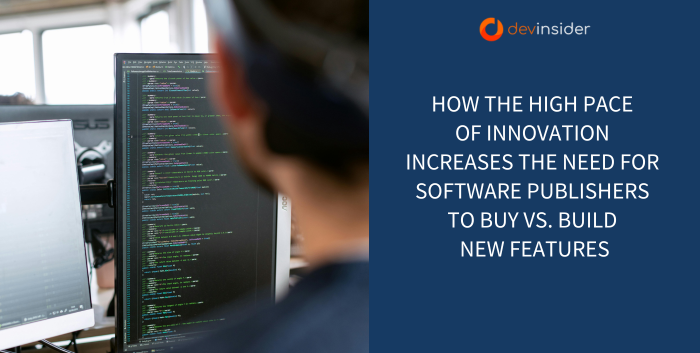Software publishers are constantly looking for ways to stay ahead of the curve and remain competitive on the market. One of the key ways they do this is through constant innovation to enhance their products to ensure the best possible customer experience. ISVs need to permanently assess what can be achieved with in-house resources and what cannot in order to stay ahead of the competition and remain relevant to end-user customers.
Companies are finding it increasingly difficult to keep up with the demand for new features and updates to their software solutions. As a result, many are turning to “buying” software features instead of building them in-house. Such features are not always the differentiating ones that create an edge over the competition, but often are requirements due to market demand. Sometimes these features are a requirement to keep your product functional (or compliant,) because your competitors offer them, or your customers demand them.
Here are the 4 main reasons why the high pace of innovation is driving this trend towards purchasing software features from external vendors.
1. Being left behind means becoming less relevant
Software businesses need to adapt quickly to new trends and technologies in order to stay ahead. For many independent software vendors, the time and resources required to develop new features in-house simply isn’t feasible. They often lack the skill-sets required to build such features, and a long time-to-market prohibits them from taking that route.
2. Do more with less
Buying software features can help businesses reduce costs and exponentially decrease the time it takes to get their enhanced product into the hands of end-user customers. Developing new features in-house can be a time-consuming and costly process, requiring businesses to invest in hiring and training developers, as well as purchasing tools and the required infrastructure. By buying software features instead, businesses can save time and money by leveraging the expertise and resources of external vendors who specialize in developing and maintaining those best-in-breed features.
3. Speed up your time to market
The time it takes to get new features on the market is one of the most fundamental parts of your product strategy. Once you have identified the need to evolve your solution, time is of the essence. If you take too long to bring those features to life, your competition will leave you in the dust. Embedding third-party solutions helps drastically speed up your time to market, which is one of the biggest advantages to “buying” versus building those feature sets yourself.
4. Focus on core competencies
Another key factor driving the trend towards buying software features is the increasing complexity of modern software systems. As systems become more advanced and interconnected, the need for specialized expertise in areas such as cybersecurity, data analytics, document management, integrated payments and machine learning, has also grown. It is simply not feasible for most software publishers to invest in hiring experts in each one of these fields. ISVs often times choose to build features that are part of their core-value proposition themselves and opt to buy features that add value but would significantly contribute to their IP.
Conclusion
The high pace of innovation in the tech industry is driving the need for businesses to purchase software features instead of building them in-house. By leveraging the expertise and resources of external vendors, businesses can quickly and easily integrate new features into their existing systems, reduce costs, improve their time-to-market, mitigate risks, and stay ahead of the curve in today’s rapidly evolving market. As the tech industry continues to evolve at a rapid pace, ISVs that want to remain competitive will need to adapt to this new reality and embrace the trend towards embedding software features from third-party vendors.
